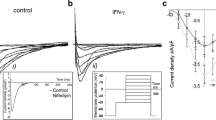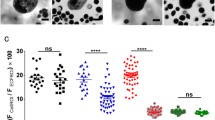Abstract
We have shown previously that the interaction between cytotoxic T lymphocytes (CTL) and ventricular myocytes, an in vitro model for heart transplant rejection, results in electrophysiological and morphological alterations indicative of overload of the intracellular [Ca2+] ([Ca2+]i). Since these deleterious effects cannot be accounted for by increased L-type Ca2+ current (I Ca,L), we hypothesize that [Ca2+]i overload due to Ca2+ release from intracellular stores, e.g. sarcoplasmic reticulum (SR), is initiated by CTL-induced activation of the inositol trisphosphate (IP3) cascade. Patch-clamp and fura-2-fluorescence techniques were utilized to record transmembrane potentials and [Ca2+]i from ventricular myocytes bound to peritoneal exudate CTL (PEL). In ventricular myocyte-PEL conjugates (after 60 min), resting potential was reduced (compared with the nonconjugated state) from –80.9 ± 0.7 to –59.9 ± 2.5 mV, action potential amplitude from 139.5 ± 1.4 to 80.6 ± 1.7 mV and action potential duration to 50% repolarization (APD50) from 797 ± 97 to 52 ± 12 ms. The ratio of fluorescence at 340 and 380 nm (R 340/380) increased from a control value (in nonconjugated myocytes) of 0.71 ± 0.02 to 2.07 ± 0.03, 30 min after conjugate formation, and exceeded 4.0 at 60 min, before myocyte destruction. Heparin (50 μg/ml), an antagonist of IP3-induced Ca2+ release from SR channels, or U-73122 (2 μM), a phospholipase C (PLC) inhibitor (drugs were included in the pipette solution), prevented PEL-induced morphological and electrophysiological alterations. Accordingly, heparin attenuated the PEL-induced increase in [Ca2+]i; after 60 min of PEL-myocyte interaction, R 340/380 was 1.15 ± 0.09 (compared with approximately 4.0 in the absence of heparin). The results indicate that CTL-mediated damage to ventricular myocytes is, at least partially, mediated by PLC activation and IP3-induced Ca2+ release from intracellular stores. Pharmacological targeting of IP3 in heart transplant rejection is thus suggested.
Similar content being viewed by others
Author information
Authors and Affiliations
Additional information
Received: 3 July 1996 / Received after revision: 21 October 1996 / Accepted: 3 December 1996
Rights and permissions
About this article
Cite this article
Felzen, B., Berke, G., Gardner, P. et al. Involvement of the IP3 cascade in the damage to guinea-pig ventricular myocytes induced by cytotoxic T lymphocytes. Pflügers Arch 433, 721–726 (1997). https://doi.org/10.1007/s004240050337
Issue Date:
DOI: https://doi.org/10.1007/s004240050337




